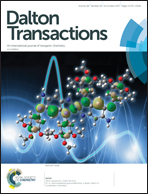Syntheses, crystal structures and magnetic properties of two mixed-valence Co(iii)Co(ii) compounds derived from Schiff base ligands: field-supported single-ion-magnet behavior with easy-plane anisotropy†
Abstract
Two μ-phenoxo-μ1,1-azide dinuclear CoIIICoII complexes [CoIII(N3)2L1(μ1,1-N3)CoII(N3)]·MeOH (1) and [CoIII(N3)2L2(μ1,1-N3)CoII(N3)]·MeOH (2) (HL1 and HL2 are two Schiff base ligands having N2O–N2O compartments) both possess one hexacoordinate Co(III) and one pentacoordinate Co(II) center. DC magnetic susceptibility and magnetization measurements show an appreciable amount of positive magnetic anisotropy (D/hc ∼ 40 cm−1) that is also confirmed by ab initio CASSCF calculations. AC susceptibility measurements of 1 reveal that it exhibits a slow magnetic relaxation with two relaxation channels. The external magnetic field supports the low-frequency (LF) channel that escapes on heating more progressively than the high-frequency (HF) branch. The relaxation time is as slow as τ = 255 ms at T = 1.9 K and BDC = 0.6 T, where the LF mole fraction is 69%. The complex 2 also displays similar field-supported slow magnetic relaxation with two relaxation channels.



 Please wait while we load your content...
Please wait while we load your content...